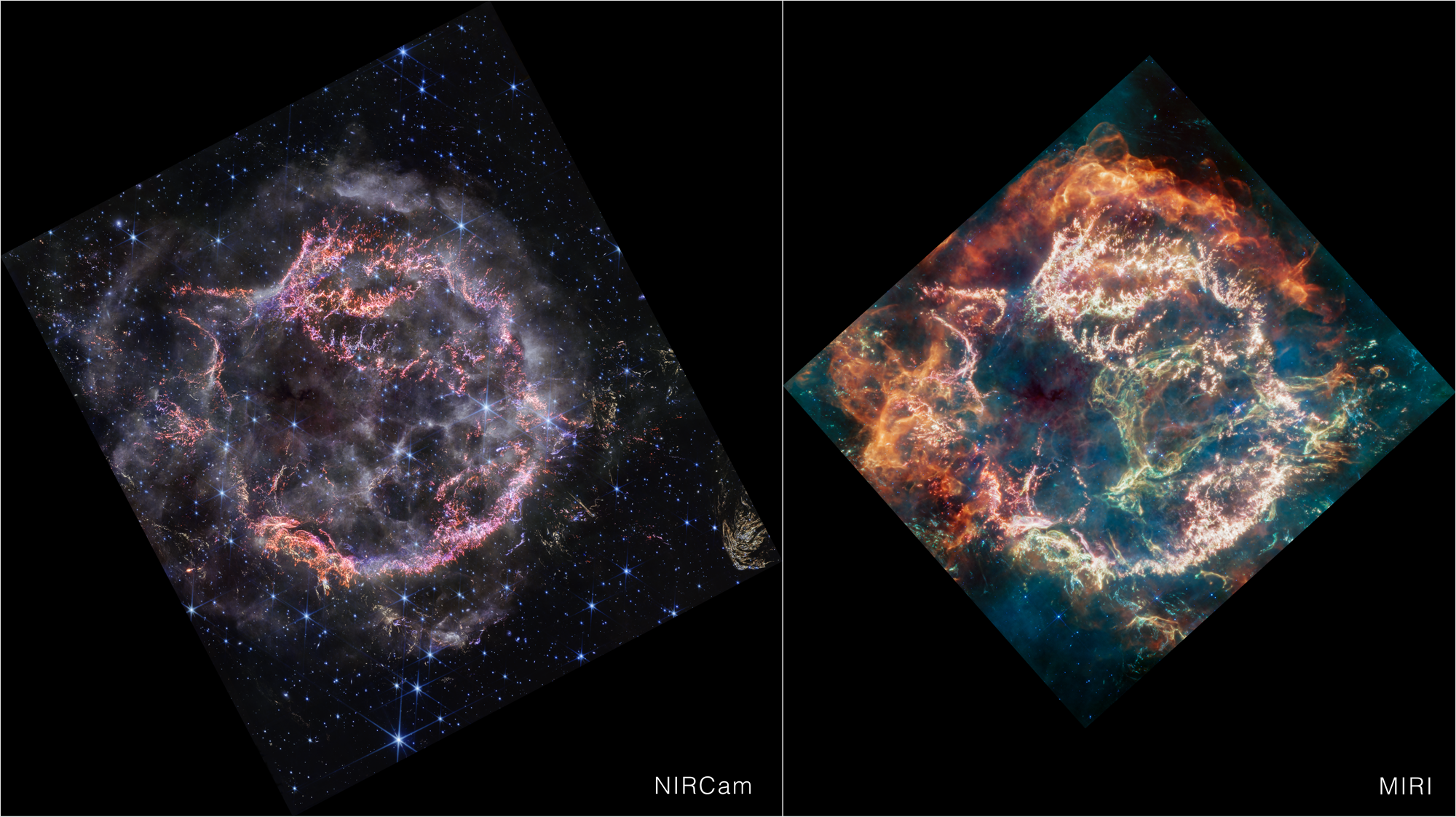JWST has studied the most recent supernova remnant in our galaxy again, using a different camera this time. In doing so it has addressed some of the questions created by its previous observations, while also revealing a giant cosmic mirror we hadn’t seen before.
The last time humanity witnessed a supernova explosion in our galaxy was 1604, but there has been at least one since then that we somehow managed to miss. After a star exploded 11,000 light-years away in the Milky Way’s Perseus Arm, the light reached us in the 1680s or 90s. Perhaps everyone was distracted by those awesome wigs, because no one noticed, despite the invention of the telescope almost a century before. That’s particularly puzzling because the location is so high in the northern sky that it never sets from northern Europe.
Astronomers may have a bone to pick with their negligent predecessors, but they’ve been making up for it since the discovery of the beautiful expanding shell of gas known as Cassiopeia A. Following the invention of radio astronomy, they learned the remnant produces the loudest radio sounds, from our perspective, outside the Solar System above 1 GHz. Indeed, the remnant is so scientifically important a telescope was launched whose sole purpose was to study its X-rays, capturing all it could in a 15-minute flight.
For all its radio and X-ray power, there are some features of Cassiopeia A that can only be revealed in the infrared, as JWST showed earlier this year when it discovered a feature promptly named the Green Monster. The area in question is not really green, since JWST operates at longer wavelengths than we can see. However, to make its output visible to our eyes, each part of the spectrum it is observing is assigned a color. The green indicated a glow at a specific wavelength, one no one expected and couldn’t explain.
Having more questions after that round of observations than they started with, astronomers couldn’t wait to take another look, but of course, the queue for JWST’s time is never-ending.
After the previous study was conducted using the space telescope’s Mid-Infrared Instrument (MIRI), the most recent study used NIRCam, which operates in the Near-Infrared, at wavelengths closer to those we can see. Consequently, the colors we see here don’t match those made with the previous image.
Indeed, this version looks less colorful because there’s less diversity in Cassiopeia A’s emissions in this part of the spectrum. For example, MIRI picks up light from the supernova blast wave smashing into circumstellar dust (shown as orange and red), but the resulting radiation is too long for NIRCam to see.
NIRCam’s image of Cassiopeia A is not as colorful as MIRI’s but it is higher resolution. The outskirts of the main inner shell, where the supernova blast wave is ramming into surrounding circumstellar material are orange and red in the MIRI image, look like smoke from a campfire in the NIRCam image. NIRCam doesn’t show the green monster, but the circular holes visible in the MIRI image within it are faintly outlined in white and purple emission in the NIRCam image.
Image Credit: NASA, ESA, CSA, STScI, Danny Milisavljevic (Purdue University), Ilse De Looze (UGent), Tea Temim (Princeton University)
Nevertheless, the image carries a resolution of around 16 billion kilometers (10 billion miles) or twice the distance from the Sun to Jupiter. With the system as a whole being 10 light-years across, that’s an exceptionally fine level of detail.
“With NIRCam’s resolution, we can now see how the dying star absolutely shattered when it exploded, leaving filaments akin to tiny shards of glass behind,” said Dr Danny Milisavljevic of Purdue University in a statement. “It’s really unbelievable after all these years studying Cas A to now resolve those details, which are providing us with transformational insight into how this star exploded.”
MIRI’s Green Monster contains mysterious bubbles or holes. In NIRCam these are fainter, and shown as white and purple, which Milisavljevic and colleagues attribute to ionized gas.
Cassiopeia A highlights: 1. NIRCam’s exquisite resolution is able to detect tiny knots comprised of sulfur, oxygen, argon, and neon gas. 2. Circular holes visible in the MIRI image within the Green Monster are faintly outlined in white and purple emission in the NIRCam image – this represents ionized gas. Researchers believe this is due to the supernova debris pushing through and sculpting gas left behind by the star before it exploded. 3. A small light echo. 4. NIRCam captured a particularly intricate and large light echo, nicknamed Baby Cas A located about 170 light-years behind the supernova remnant.
Image Credit: NASA, ESA, CSA, STScI, Danny Milisavljevic (Purdue University), Ilse De Looze (UGent), Tea Temim (Princeton University)
Besides offering a new view on things MIRI revealed, NIRCam has allowed us to see something not spotted in any other wavelength. It’s a blob in the bottom right corner that’s been named Baby Cas A because it looks as though the remnant gave birth to it.
In fact, it is what astronomers call a “light echo”, where radiation emitted by the explosion has warmed a patch of dust so that it radiates at near-infrared wavelengths. Baby Cas A is about 170 light-years behind Cassiopeia A, so the explosion’s light took an extra 340 years to travel there and then for the infrared radiation to come to us. As a result, it is just reaching us now, 340 years after all the light we did not see. Several smaller light echoes can also be seen.
Source Link: JWST Revisits Famous Supernova Remnant Cassiopeia A And Finds Even More Mysterious Features
